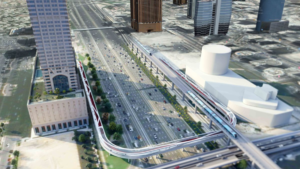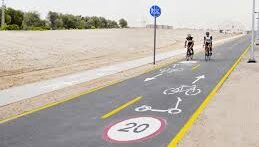Calling all cyclists and eco-conscious commuters in Dubai! The city is about to unveil a brand new cycling track, connecting two major neighbourhoods – Al Sufouh and Dubai Hills. This exciting development is part of a larger initiative by the Roads and Transport Authority (RTA) to promote cycling as a viable and healthy mode of transportation across Dubai.

The cycling track will be a significant 13.5km stretch, connecting residents and visitors with a convenient and scenic route between these two popular areas. This addition to Dubai’s cycling infrastructure aligns with the city’s goals of reducing car dependency, improving public health, and alleviating traffic congestion – a welcome change for many residents.
Cycling Track Highlights: A Network for Cyclists, Pedestrians, and Scooters
This new cycling track is not just about connecting Al Sufouh and Dubai Hills. It’s about creating a dedicated network for alternative modes of transportation within the city. The track will be designed to accommodate bicycles, scooters, and pedestrians, promoting a more sustainable and inclusive transportation landscape.
Connecting the Gap: Two New Bridges for Seamless Cycling
To ensure a continuous and uninterrupted cycling experience, the RTA will be constructing two new bridges along the route. These bridges will connect the cycling track across major roadways – one spanning Sheikh Zayed Road and the other traversing Al Khail Road. Both bridges will be impressive feats of engineering, exceeding 500 meters in length and featuring separate lanes for cyclists and pedestrians. This design prioritizes safety and creates a comfortable environment for all users. Additionally, the bridges will conveniently connect with the Dubai Internet City metro station, offering a convenient multi-modal transportation option.
Beyond Cycling: The Hessa Street Project Takes Shape
The new cycling track is just one aspect of a larger project – the Hessa Street project. This comprehensive initiative encompasses several improvements to the Hessa Street corridor. The project will see an increase in traffic lanes on the existing road, along with the creation of four new intersections. These improvements aim to enhance traffic flow and accommodate the growing number of vehicles serving communities like Al Sufouh, Al Barsha, and Barsha Heights. By 2030, the Hessa Street project is expected to accommodate an additional 8,000 vehicles on the road network.
A Vision for the Future: Encouraging Active Mobility
His Excellency Mattar Al Tayer, Director-General and Chairman of the Board of Directors of the RTA, expressed his enthusiasm for the project, highlighting the unique features of the cycling track. He emphasized the significance of the two bridges, connecting cyclists and pedestrians across major roads with dedicated lanes for each user group. Mr. Al Tayer further elaborated on the unique geometric design of the bridge crossing Al Khail Road, inspired by the surrounding environment.
The Dubai cycling track project represents a significant step forward for the city’s commitment to sustainable and healthy transportation options. This new addition, along with the broader Hessa Street project, paves the way for a more connected, cycling-friendly Dubai, encouraging residents to embrace active mobility and explore the city on two wheels.

